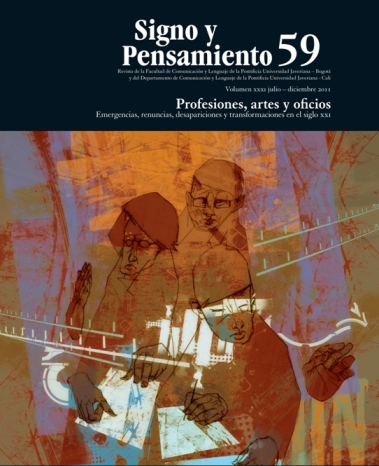Abstract
This article presents the analysis and the results of the second phase of the research “Quality standards of the information published in national and local media, regarding security in Bogotá”. This research was developed by the Media Observatory of the Communication and Language School of the Pontificia Universidad Javeriana, with the sponsorship of the Chamber of Commerce of Bogota. After using the technique of content analysis over a corpus of more than a thousand news pieces (recovered in a period of time between May 20 and November 20, 2008) the results of the processed data were compared to the perceptions and the reports of 28 judicial reporters and editorialists of 10 local and national media. This analysis was made based on journalism sociology and the theories of news-making, agenda setting, and framing.
Barata, F. (2007), “Los medios, el crimen y la seguridad pública”, en Violencia y Medios, vol. 3, p. 29.
Bonilla, J. I. y Cadavid, A. (2004), ¿Qué es noticia?, agendas, periodistas y ciudadanos, Bogotá, Cátedra Konrad Adenauer y Facultad Comunicación y Lenguaje, Pontificia Universidad Javeriana, Antropos.
Gutiérrez, L. (2006), “Análisis de la calidad informativa, primer paso hacia el cambio”, Palabra Clave, núm. 9, Universidad de La Sabana, pp. 29-56.
Kovach, B. y Rosensthiel, T. (2003), Los elementos del periodismo, Madrid, El País.
Lara, M. y López Portillo, E. (coords.) (2004), Violencia y medios 1. Seguridad pública, noticias y construcción del miedo, México, Instituto para la Seguridad y la Democracia, AC/Centro de Investigación y Docencia Económicas.
Martín-Barbero, J. (2000), “La ciudad: entre medios y miedos”, en Rotker, S., Ciudadanías del miedo, Caracas, Nuevas Sociedades.
Martini, S. (2007), Los relatos periodísticos del crimen [documento 2], Bogotá, FES.
Martini, S. y Luchessi, L. (2004), Los que hacen la noticia. Periodismo, información y poder, Buenos Aires, Biblos.
Pellegrini, S. (1999), “La medición de la calidad de la prensa en Chile”, Cuadernos de Información, núm. 13, Universidad Católica de Chile, pp. 49-55.
Restrepo, J. D. (2004), El zumbido y el moscardón. Taller y consultorio de ética periodística, México, Fundación Nuevo Periodismo Iberoamericano.
Rey, G. y Rincón, O. (2008), Más allá de víctimas y culpables [relatos de experiencias en seguridad ciudadana y comunicación-América Latina] [documento 6], Bogotá, FES, Centro de Competencia en Comunicación.
Ronda Iglesias, J. (1999), “Los retos del periodismo judicial”, Revista Latina de Comunicación Social [en línea], disponible en http://www. ull.es/publicaciones/latina/a1999c/116ronda. htm, recuperado: 10 de julio de 2011.
Ruiz Vásquez, J. C. (2006), La tenue línea de la tranquilidad. Estudio comparado sobre seguridad ciudadana y policía, Bogotá, Facultad de Ciencia Política y de Gobierno, Universidad del Rosario.
This journal is registered under a Creative Commons Attribution 4.0 International Public License. Thus, this work may be reproduced, distributed, and publicly shared in digital format, as long as the names of the authors and Pontificia Universidad Javeriana are acknowledged. Others are allowed to quote, adapt, transform, auto-archive, republish, and create based on this material, for any purpose (even commercial ones), provided the authorship is duly acknowledged, a link to the original work is provided, and it is specified if changes have been made. Pontificia Universidad Javeriana does not hold the rights of published works and the authors are solely responsible for the contents of their works; they keep the moral, intellectual, privacy, and publicity rights.
Approving the intervention of the work (review, copy-editing, translation, layout) and the following outreach, are granted through an use license and not through an assignment of rights. This means the journal and Pontificia Universidad Javeriana cannot be held responsible for any ethical malpractice by the authors. As a consequence of the protection granted by the use license, the journal is not required to publish recantations or modify information already published, unless the errata stems from the editorial management process. Publishing contents in this journal does not generate royalties for contributors.


